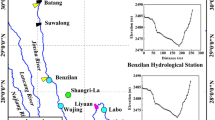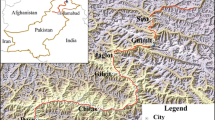Abstract
An Ms 6.5 earthquake shocked the Ludian County, Yunnan Province, China, on 3 August 2014 and triggered the Hongshiyan landslide dam. The dam, with a height of 83 m and a lake capacity of 260 × 106 m3, threatened more than 10,000 people. A unique feature of this landslide dam was that it formed between a man-made dam and a hydropower plant. An existing drainage tunnel connecting the lake and the hydropower plant became a natural drainage conduit for the landslide dam, which played an important role in the mitigation of the landslide dam risks. This paper reports a quantitative risk assessment for the Hongshiyan landslide dam considering both engineering and non-engineering risk mitigation measures. The risk assessment is divided into three stages according to the implementation of two engineering measures: construction of a diversion channel and excavation of a branch drainage tunnel. The dam breaching hydrographs, flood zones, population at risk, and likely fatalities in each of the three stages are analysed. The optimum evacuation strategy in each stage is also studied based on the principle of minimum total consequence. It is found that the diversion channel decreases the dam breaching peak discharge and the associated risks significantly. The branch drainage tunnel prevent the landslide dam from overtopping failure in non-flooded period; however, the landslide dam may fail by overtopping in a future flood if the inflow rate is larger than the outflow rate through the drainage tunnels, resulting in serious losses of lives and properties. The dam breaching risks in all the three stages could be largely reduced by the optimal evacuation decision, which shows that timely evacuation is vital to save life and properties. The study provides a scientific basis for decision making in landslide dam risk management.
















Similar content being viewed by others
References
Cai W (2014) 30 soldiers from Armed Police Hydropower Troops took risk mitigation measures for landslide dams in Yunnan. Xhby.net. online: http://js.xhby.net/system/2014/08/08/021583443.shtml (in Chinese)
Chang DS, Zhang LM (2010) Simulation of the erosion process of landslide dams due to overtopping considering variations in soil erodibility along depth. Nat Hazards Earth Syst Sci 10(4):933–946
Chang ZF, Chen XL, An XW, Cui JW (2015) Why the 2014 Ludian, Yunnan, China Ms 6.5 earthquake triggered an unusually large landslide? Nat Hazards Earth Syst Sci Discuss 3:367–399
China Earthquake Administration (2014) China Earthquake Administration released intensity map of Ludian Ms 6.5 earthquake. cea.gov.cn. online: http://www.cea.gov.cn/publish/dizhenj/464/478/20140807085249557322083/index.html. Accessed 07 Aug 2014 (in Chinese)
Costa JE, Schuster RL (1988) The formation and failure of natural dams. Geol Soc Am Bull 100(7):1054–1068
Cui P, Zhu YY, Han YS, Chen XQ, Zhuang JQ (2009) The 12 May Wenchuan earthquake-induced landslide lakes: distribution and preliminary risk evaluation. Landslides 6(3):209–223
Dunning SA, Rosser NJ, Petley DN, Massey CR (2006) Formation and failure of the Tsatichhu landslide dam, Bhutan. Landslides 3(2):107–113
Ermini L, Casagli N (2003) Prediction of the behaviour of landslide dams using a geomorphological dimensionless index. Earth Surf Process Land 28(1):31–47
Evans SG, Delaney KB, Hermanns RL, Strom A, Scarascia-Mugnozza G (2011) The formation and behaviour of natural and artificial rockslide dams; implications for engineering performance and hazard management. In: Evans SG, Hermanns RL, Strom A, Scarascia-Mugnozza G (eds) Natural and Artificial Rockslide Dams, Lecture Notes in Earth Sciences, p 1–75
Fread DL (1988) BREACH: an erosion model for earth dam failures, National Weather Service (NWS) Report. NOAA, Silver Spring, Maryland, USA
Frieser B (2004) Probabilistic evacuation decision model for river floods in the Netherlands. Final report, Delft University of Technology, Netherlands, p 138
Google Map (2014) Ludian. google.cn. online: http://ditu.google.cn/. Accessed 10 Dec 2014
Hydrologic Engineering Centre (HEC) (2008) HEC-RAS, river analysis system, hydraulic reference manual, version 4.0, developed by Hydrologic Engineering Centre of US Army Corps of Engineers, Washington
Jensen FV (2001) Bayesian networks and decision graphs. Springer, New York
Jonkman SN (2007) Loss of life estimation in flood risk assessment: theory and applications. Delft University of Technology, Delft, Netherlands, Ph D Thesis
Korup O (2002) Recent research on landslide dams—a literature review with special attention to New Zealand. Prog Phys Geogr 26(2):206–235
Liu N (2014) Hongshiyan landslide dam danger removal and coordinated management. Front Eng Mgt 1(3):308–317
Liu W, He SM (2015) A two-layer model for simulating landslide dam over mobile river beds. Landslides, Online: doi 10.1007/s10346-015-0585-2
Peng M, Zhang LM (2012a) Breaching parameters of landslide dams. Landslides 9(1):13–31
Peng M, Zhang LM (2012b) Analysis of human risks due to dam-break floods—part 1: a new model based on Bayesian networks. Nat Hazards 64(1):903–933
Peng M, Zhang LM (2012c) Analysis of human risk due to dam break floods—part 2: application to Tangjiashan landslide dam failure. Nat Hazards 64(2):1899–1923
Peng M, Zhang LM (2013a) Dynamic decision making for dam-break emergency management—part 1: theoretical framework. Nat Hazards Earth Syst Sci 13(2):425–437
Peng M, Zhang LM (2013b) Dynamic decision making for dam-break emergency management—part 2: application to Tangjiashan landslide dam failure. Nat Hazards Earth Syst Sci 13(2):439–454
Peng M, Zhang LM, Chang DS, Shi ZM (2014) Engineering risk mitigation measures for the landslide dams induced by the 2008 Wenchuan earthquake. Eng Geol 180:68–84
QQ News (2014) Photos: the Ludian landslide drainage completed and the submerged village seen. qq.com. online: http://news.qq.com/a/20141007/001967.htm. Accessed 07 Oct 2014 (in Chinese)
Schuster RL (2006) Risk-reduction measures for landslide dams. J Eng Geol Environ Spec Issue 1:9–13
Schuster RL, Evans SG (2011) Engineering measures for the hazard reduction of landslide dams. In: Evans SG, Hermanns RL, Strom A, Scarascia-Mugnozza G (eds) Natural and Artificial Rockslide Dams, Lecture Notes in Earth Sciences, p 77–100
Song XB, Wu Y, Luo ZY (2012) Analysis of runoff characteristic change and influence on Jinsha River basin. Heilongjiang Sci Technol Water Conserv 40(7):3–5 (in Chinese)
Sun YF (2014) The spillway of Hongshiyan landslide dam had been completed in Ludian, Yunnan.youth.cn. online: http://picture.youth.cn/qtdb/201408/t20140813_5623776.htm. Accessed 12 Aug 2014
Zhang LM, Zhang S, Huang RQ (2014) Multi-hazard scenarios and consequences in Beichuan, China: the first five years after the 2008 Wenchuan earthquake. Eng Geol 180:4–20
Zhaotong Municipal Bureau of Statistics (ZMBS) (2014) Statistical bulletin for national economic and social development in 2013 of Zhaotong. ztstats.gov.cn. online: http://www.ztstats.gov.cn/tjgb/3724483861722924763. Accessed 12 Mar 2014 (in Chinese)
Acknowledgments
The research reported in this paper was substantially supported by the Natural Science Foundation of China (Nos. 41372272, 41402257 and 51129902), the Shanghai Pujiang Program (14PJ1408200), the Major State Basic Research Development Program of China (973 Program) (No. 2013CB036404), and the Program for Young Excellent Talents in Tongji University (20131942). Special thanks are due to Mr. Wang Shuping for his useful information.
Author information
Authors and Affiliations
Corresponding author
Rights and permissions
About this article
Cite this article
Shi, Z.M., Xiong, X., Peng, M. et al. Risk assessment and mitigation for the Hongshiyan landslide dam triggered by the 2014 Ludian earthquake in Yunnan, China. Landslides 14, 269–285 (2017). https://doi.org/10.1007/s10346-016-0699-1
Received:
Accepted:
Published:
Issue Date:
DOI: https://doi.org/10.1007/s10346-016-0699-1




